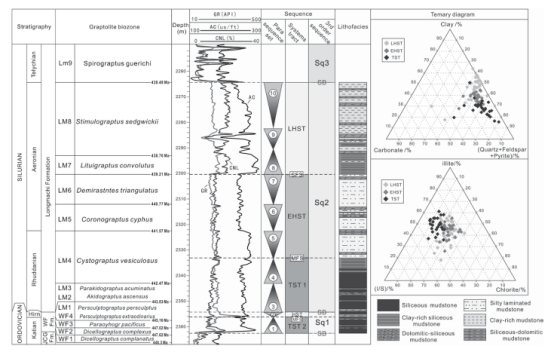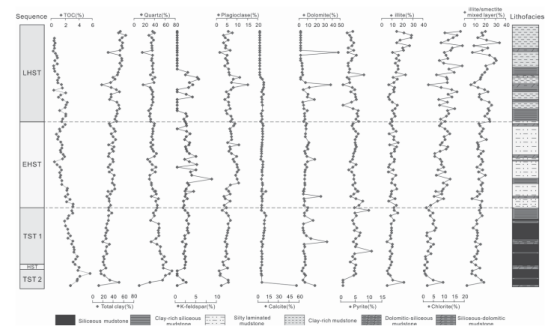“Multiscale petrographic heterogeneity and their implications for the nanoporous system of the Wufeng-Longmaxi shales in Jiaoshiba area, Southeast China: Response to depositional-diagenetic process” was published online in GSA Bulletin on December 17, 2019. It is an achievement of doctoral student WANG Yuxuan from the School of Earth Resources and his research partners. WANG is the first author.
The organic matter-rich shales in Wufeng-Longmaxi Formation, Jiaoshiba area, Southeast China, are showing a notable petrographic heterogeneity characteristic within the isochronous stratigraphic framework, which lead to vast differences in the mineral composition and organic matter abundance in the adjacent sections of the shale reservoir. The studied shale has been divided into three systems tracts: a transgressive systems tract (TST), an early highstand systems tract (EHST), and a late highstand systems tract (LHST). Multiple-scale petrographic observation and detailed mineralogical and geochemical analyses were combined to investigate the manifestation, origin, and the ways by which the shale heterogeneity is affected. The results indicate that polytropic depositional environments lead to different components in sediment. Subsequently, these differences among shale sections become more apparent through different diagenetic pathways. During the deposition of the section TST, the Hirnantian glaciation and regional volcanism played a crucial role, contributing to the abundant accumulation of fine-grained intrabasinal silica and organic matter. In diagenesis stage, authigenic quartz aggregates derived from siliceous organisms are formed. They filled in primary interparticle pores, forming a rigid particle-bracing structure that provide effective resistivity against the compaction and spaces for organic matter migration and occlusion. Finally, the migrated organic matter left plenty of newly created pore spaces that constituted a great portion of the total porosity of shale reservoir. The depositional process of section EHST is strongly influenced by contour current, which brings about more extrabasinal influx and impoverishes organic matter. In diagenesis stage, the rigid particle-bracing structure could only be preserved in limited areas, since insufficient siliceous supply could not produce enough authigenic quartz. Primary interparticle pores are significantly reduced owing to compaction, leaving less space for later organic matter migration and occlusion. As a result, the total porosity of shale reservoir declines in this section. In a rapid tectonic-uplifting background, the deposition of section LHST is associated with a rapid increase in terrigenous clay minerals, which further dilutes organic matter. Ductile clay experienced strong compaction and then occupies most of the primary interparticle space. Rigid particles are wrapped by a large number of clays, which has destroyed the particle-bracing structure. As a result, the nanoporous system in the shale could not be well preserved.

Figure 1. (A) Thickness distribution of organic-rich shales of the Wufeng-Longmaxi Formation in the upper Yangtze area, China.(B) Stratigraphic column of the Wufeng and Longmaxi formations. Sys.—system.

Figure 2. Stratigraphic framework construction of the Wufeng-Longmaxi Formation in Jiaoshiba area, Southeast China, of Well A through a comprehensive interpretation of well logging, lithology, and graptolite zonation. HST—highstand systems tract; LHST—late highstand systems tract; EHST—early highstand systems tract; TST—transgression systems tract; GR—natural gamma ray logging; AC—acoustic logging; CNL—neutron logging; MFS—maximum flooding surface; SFS—sub flooding surface; SB—sequence boundary; Hirn—Hirnantian; Fm.—Formation; JCG—Jiancaogou Formation; WF—Wufeng Formation; I/S—mixed layer minerals of illite and smectit.

Figure 3. Mineral and organic matter contents variation within the stratigraphic framework. HST—highstand systems tract; LHST—late highstand systems tract; EHST—early highstand systems tract; TST—transgression systems tract; I-S—illite/smectite mixed layer; TOC—total organic carbon.
Full Text: https://pubs.geoscienceworld.org/gsabulletin/early-publication